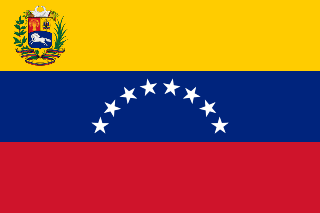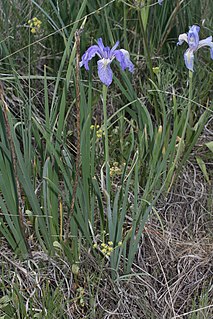
Iris is a genus of 260–300 species of flowering plants with showy flowers. It takes its name from the Greek word for a rainbow, which is also the name for the Greek goddess of the rainbow, Iris. Some authors state that the name refers to the wide variety of flower colors found among the many species. As well as being the scientific name, iris is also widely used as a common name for all Iris species, as well as some belonging to other closely related genera. A common name for some species is 'flags', while the plants of the subgenus Scorpiris are widely known as 'junos', particularly in horticulture. It is a popular garden flower.

In humans and most mammals and birds, the iris is a thin, circular structure in the eye, responsible for controlling the diameter and size of the pupil and thus the amount of light reaching the retina. Eye color is defined by that of the iris. In optical terms, the pupil is the eye's aperture, while the iris is the diaphragm.

The fleur-de-lis or fleur-de-lys is a stylized lily that is used as a decorative design or motif. Many of the Catholic saints of France, particularly St. Joseph, are depicted with a lily. Since France is a historically Catholic nation, the fleur-de-lis became "at one and the same time, religious, political, dynastic, artistic, emblematic, and symbolic", especially in French heraldry.

Iridaceae is a family of plants in order Asparagales, taking its name from the irises, meaning rainbow, referring to its many colours. There are 66 accepted genera with a total of c. 2244 species worldwide. It includes a number of other well known cultivated plants, such as freesias, gladioli and crocuses.

The current flag of Venezuela was introduced in 2006. The basic design includes a horizontal tricolor of yellow, blue, and red, dating to the original flag introduced in 1811, in the Venezuelan War of Independence with eight stars in the centre.

Heterochromia is a difference in coloration, usually of the iris but also of hair or skin. Heterochromia is determined by the production, delivery, and concentration of melanin. It may be inherited, or caused by genetic mosaicism, chimerism, disease, or injury. It occurs in humans and certain breeds of dogs and cats.

Eye color is a polygenic phenotypic character determined by two distinct factors: the pigmentation of the eye's iris and the frequency-dependence of the scattering of light by the turbid medium in the stroma of the iris.

Iris sibirica, is a species in the genus Iris. It is a rhizomatous herbaceous perennial, from Europe and Central Asia. It has long green grass-like leaves, tall stem, 2–5 violet-blue, to blue, and occasionally white flowers. It is cultivated as an ornamental plant in temperate regions.

Iris giganticaerulea is a species of iris, it is also in the subgenus of Limniris and in the Series Hexagonae. It is a rhizomatous perennial, from northern America. It has long bright green leaves, very tall stems, 1–2 musky fragrant flowers, in a range of blue shades, from pale blue, to lavender blue, to bright blue, to dark blue, and to violet blue. Rarely, there is a white form.
Blue flag or Blue Flag may refer to:

Iris tenax is a species of Iris, known by the common names tough-leaved iris, Oregon iris, or more colloquially, flag.

Iris missouriensis is a hardy flowering rhizomatous species of the genus Iris, in the family Iridaceae. Its common names include western blue flag, Rocky Mountain iris, and Missouri flag.

The Flag of the Brussels-Capital Region consists of a stylized yellow, grey and white iris on a blue background. Note that this is the flag of the whole Brussels Region, and the City of Brussels municipality has a different flag.
There are currently two symbols of the Brussels. Both the flag and the emblem of the Brussels-Capital Region depict the Iris pseudacorus, a flower native to the Brussels area. Additionally, every municipality of the region has its own flag and coat of arms.

Iridin is an isoflavone, a type of flavonoid. It is the 7-glucoside of irigenin and can be isolated from several species of irises like orris root, Iris florentina or Iris versicolor, also commonly known as the larger blue flag. It can also be found in Iris kemaonensis.

Iris setosa, is a species in the genus Iris, it is also in the subgenus of Limniris and in the Iris series Tripetalae. It is a rhizomatous perennial from a wide range across the Arctic sea, including Alaska, Maine, Canada, Russia, northeastern Asia, China, Korea and southwards to Japan. The plant has tall branching stems, mid green leaves and violet, purple-blue, violet-blue, blue, to lavender flowers. There are also plants with pink and white flowers.

Patersonia sericea, commonly known as the purple flag, native iris, silky purple flag or native flag is a species of plant in the iris family Iridaceae which is endemic to eastern Australia. It is relatively easy to cultivate, and even the type specimen provided to the taxonomist, Robert Brown was "...furnished us by Messrs. Lee and Kennedy, of Hammersmith, [West London] who received the seeds, from which they raised it, from Port Jackson".

















